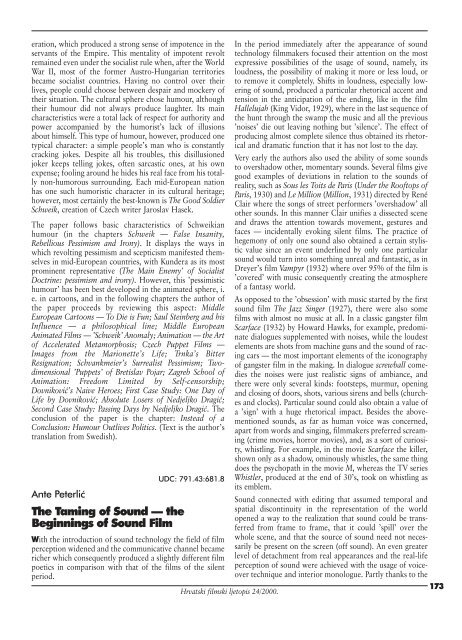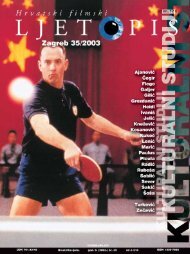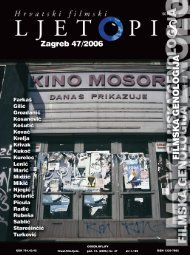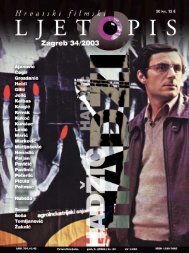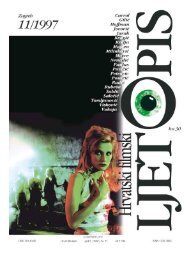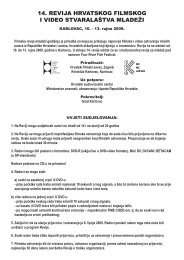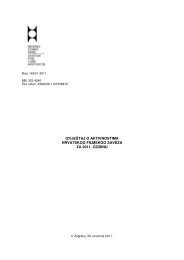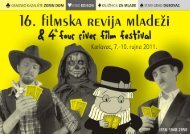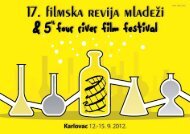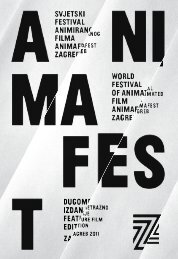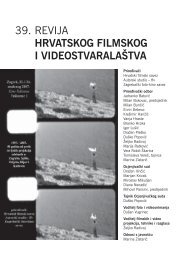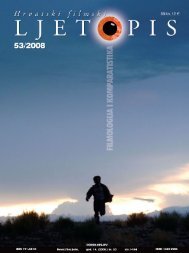Create successful ePaper yourself
Turn your PDF publications into a flip-book with our unique Google optimized e-Paper software.
eration, which produced a strong sense of impotence in the<br />
servants of the Empire. This mentality of impotent revolt<br />
remained even under the socialist rule when, after the World<br />
War II, most of the former Austro-Hungarian territories<br />
became socialist countries. Having no control over their<br />
lives, people could choose between despair and mockery of<br />
their situation. The cultural sphere chose humour, although<br />
their humour did not always produce laughter. Its main<br />
characteristics were a total lack of respect for authority and<br />
power accompanied by the humorist’s lack of illusions<br />
about himself. This type of humour, however, produced one<br />
typical character: a simple people’s man who is constantly<br />
cracking jokes. Despite all his troubles, this disillusioned<br />
joker keeps telling jokes, often sarcastic ones, at his own<br />
expense; fooling around he hides his real face from his totally<br />
non-humorous surrounding. Each mid-European nation<br />
has one such humoristic character in its cultural heritage;<br />
however, most certainly the best-known is The Good Soldier<br />
Schweik, creation of Czech writer Jaroslav Hasek.<br />
The paper follows basic characteristics of Schweikian<br />
humour (in the chapters Schweik — False Insanity,<br />
Rebellious Pessimism and Irony). It displays the ways in<br />
which revolting pessimism and scepticism manifested themselves<br />
in mid-European countries, with Kundera as its most<br />
prominent representative (The Main Enemy’ of Socialist<br />
Doctrine: pessimism and irony). However, this ’pessimistic<br />
humour’ has been best developed in the animated sphere, i.<br />
e. in cartoons, and in the following chapters the author of<br />
the paper proceeds by reviewing this aspect: Middle<br />
European Cartoons — To Die is Fun; Saul Steinberg and his<br />
Influence — a philosophical line; Middle European<br />
Animated Films — ’Schweik’ Anomaly; Animation — the Art<br />
of Accelerated Metamorphosis; Czech Puppet Films —<br />
Images from the Marionette’s Life; Trnka’s Bitter<br />
Resignation; Schvankmeier’s Surrealist Pessimism; Twodimensional<br />
’Puppets’ of Bretislav Pojar; Zagreb School of<br />
Animation: Freedom Limited by Self-censorship;<br />
Dovnikovi}’s Naive Heroes; First Case Study: One Day of<br />
Life by Dovnikovi}; Absolute Losers of Nedjeljko Dragi};<br />
Second Case Study: Passing Days by Nedjeljko Dragi}. The<br />
conclusion of the paper is the chapter: Instead of a<br />
Conclusion: Humour Outlives Politics. (Text is the author’s<br />
translation from Swedish).<br />
Ante Peterli}<br />
The Taming of Sound — the<br />
Beginnings of Sound Film<br />
UDC: 791.43:681.8<br />
With the introduction of sound technology the field of film<br />
perception widened and the communicative channel became<br />
richer which consequently produced a slightly different film<br />
poetics in comparison with that of the films of the silent<br />
period.<br />
Hrvatski filmski ljetopis <strong>24</strong>/<strong>2000</strong>.<br />
In the period immediately after the appearance of sound<br />
technology filmmakers focused their attention on the most<br />
expressive possibilities of the usage of sound, namely, its<br />
loudness, the possibility of making it more or less loud, or<br />
to remove it completely. Shifts in loudness, especially lowering<br />
of sound, produced a particular rhetorical accent and<br />
tension in the anticipation of the ending, like in the film<br />
Hallelujah (King Vidor, 1929), where in the last sequence of<br />
the hunt through the swamp the music and all the previous<br />
’noises’ die out leaving nothing but ’silence’. The effect of<br />
producing almost complete silence thus obtained its rhetorical<br />
and dramatic function that it has not lost to the day.<br />
Very early the authors also used the ability of some sounds<br />
to overshadow other, momentary sounds. Several films give<br />
good examples of deviations in relation to the sounds of<br />
reality, such as Sous les Toits de Paris (Under the Rooftops of<br />
Paris, 1930) and Le Million (Million, 1931) directed by René<br />
Clair where the songs of street performers ’overshadow’ all<br />
other sounds. In this manner Clair unifies a dissected scene<br />
and draws the attention towards movement, gestures and<br />
faces — incidentally evoking silent films. The practice of<br />
hegemony of only one sound also obtained a certain stylistic<br />
value since an event underlined by only one particular<br />
sound would turn into something unreal and fantastic, as in<br />
Dreyer’s film Vampyr (1932) where over 95% of the film is<br />
’covered’ with music consequently creating the atmosphere<br />
of a fantasy world.<br />
As opposed to the ’obsession’ with music started by the first<br />
sound film The Jazz Singer (1927), there were also some<br />
films with almost no music at all. In a classic gangster film<br />
Scarface (1932) by Howard Hawks, for example, predominate<br />
dialogues supplemented with noises, while the loudest<br />
elements are shots from machine guns and the sound of racing<br />
cars — the most important elements of the iconography<br />
of gangster film in the making. In dialogue screwball comedies<br />
the noises were just realistic signs of ambiance, and<br />
there were only several kinds: footsteps, murmur, opening<br />
and closing of doors, shots, various sirens and bells (churches<br />
and clocks). Particular sound could also obtain a value of<br />
a ’sign’ with a huge rhetorical impact. Besides the abovementioned<br />
sounds, as far as human voice was concerned,<br />
apart from words and singing, filmmakers preferred screaming<br />
(crime movies, horror movies), and, as a sort of curiosity,<br />
whistling. For example, in the movie Scarface the killer,<br />
shown only as a shadow, ominously whistles, the same thing<br />
does the psychopath in the movie M, whereas the TV series<br />
Whistler, produced at the end of 30’s, took on whistling as<br />
its emblem.<br />
Sound connected with editing that assumed temporal and<br />
spatial discontinuity in the representation of the world<br />
opened a way to the realization that sound could be transferred<br />
from frame to frame, that it could ’spill’ over the<br />
whole scene, and that the source of sound need not necessarily<br />
be present on the screen (off sound). An even greater<br />
level of detachment from real appearances and the real-life<br />
perception of sound were achieved with the usage of voiceover<br />
technique and interior monologue. Partly thanks to the<br />
173


